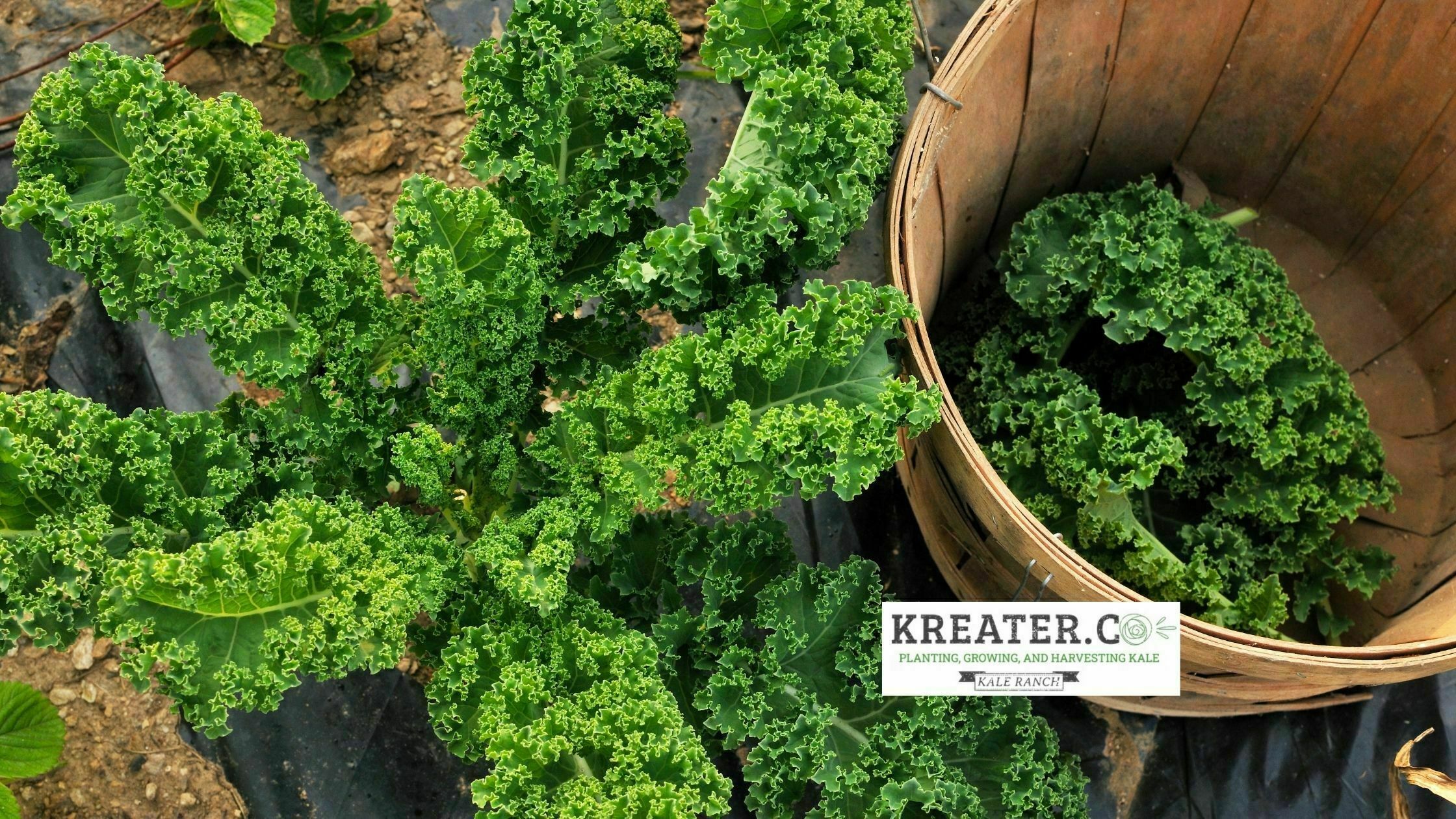Discover how to harvest kale in 7 easy steps for maximum yield. This definitive guide makes kale harvesting a breeze, even for beginners.
For the gardener in you that’s been waiting to come out, we know you’ve wanted to grow kale but are riddled with questions like how to harvest kale, and we hear you, you are not alone in your quest for getting the best kale possible. You, my friend, are in the right place because we’ll be covering tips and tricks and everything you need to know about how to harvest kale, even if you are a beginner.
Since you probably know how kale is this fantastic powerhouse of nutrients and just how good it is for our bodies and how good it tastes in salads, in a smoothie, braised or sautéed, and even as crunchy kale chips; then you probably start to wonder why not have it available at your own garden. And you are right, and you should because even if you worry about how to harvest kale, know that kale is easy to grow and a low-maintenance kind of plant, and anyone can learn how to do it.
How to Harvest Kale – Quick Guide
- Select and Cut the Kale Leaf: Start by grasping a kale leaf firmly but gently. With your other hand, use pruning shears to make a clean cut at the base of the stem. Ensure your shears are sharp and clean to avoid damaging the plant or introducing disease.
- Collect the Cut Leaves: After cutting, carefully place each leaf in a bucket or basket. This will protect the leaves from getting bruised or dirty. The bucket also makes it easier to transport the leaves from your garden to your kitchen.
- Clean the Harvested Kale: Once you’ve picked all the kale you need, it’s time to wash the freshly cut leaves. Fill your sink with cool water and gently swish the leaves around to remove any dirt or bugs. Rinse them thoroughly under running water and then pat dry with a clean towel or use a salad spinner to remove excess water.
- Prepare and Enjoy Your Fresh Kale: Now that your kale is clean, you can start cooking. Kale can be used in a variety of dishes like salads, soups, stews, and stir-fries. You can even bake them into crispy kale chips. Remember, the fresher the kale, the better it tastes. So, try to use your harvested kale as soon as possible for the best flavor and nutrition.
How To Harvest kale 2 Things To Keep In Mind
- Make sure your plant is ready to harvest. First, you need to need to make sure that your kale plant is ready to harvest. You’ll know when it’s ready when it’s about 12 inches tall, and the leaves are the size of your hand or bigger. Leaves that are the size of your palm are younger and more tender, whereas the bigger leaves will be older and a bit tougher.
- Harvest from the bottom up. It’s also important that you harvest kale from the bottom up. Pruning the top leaves can accidentally stunt the growth of your kale plant. Feel free to cut off any yellowing leaves to help your plant really focus its energy on growing the other healthy leaves.
How To Harvest Kale – Essential Tools
Harvesting kale requires a few essential tools to ensure you get the best yield with minimal damage to the plant. Here’s a detailed look at what you’ll need:
Pruning Shears or a Pruning Knife
When harvesting kale, it’s crucial to make clean, sharp cuts to prevent damaging the plant and stunting future growth. A pair of pruning shears or a pruning knife is ideal for this task. These tools allow for precision cutting at the base of the stem without tearing or bruising the leaf. Make sure your tool of choice is sharp and clean before you start to ensure the best results.
A Large Bowl or Bucket
Once you’ve cut your kale leaves, you’ll need somewhere to put them. A large bowl or bucket is perfect for this. It should be sturdy and easy to carry, as you’ll be moving around your garden while harvesting. This container will hold your freshly cut kale leaves, keeping them in a clean, controlled environment until you’re ready to wash and prepare them.
Optional but helpful tools can include gloves, to protect your hands from the rough texture of mature kale, and a garden cart or wheelbarrow for larger harvests. Remember, the right tools can make all the difference when it comes to successfully harvesting and enjoying your homegrown kale.
How To Harvest Kale – A Detailed Guide
Harvesting kale is a straightforward process. Follow these steps to ensure a successful harvest:
Step 1: Select and Cut the Kale Leaf
- Choose the right leaves: Look for mature, dark green leaves. These are usually located at the lower part of the plant. The younger, smaller leaves at the top of the plant should be left to continue growing.
- Cut the leaf: Grasp a kale leaf firmly but gently. With your other hand, use your pruning shears or knife to make a clean cut at the base of the stem.
- Ensure tool cleanliness: Make sure your tool is sharp and clean to avoid damaging the plant or introducing disease. A dull tool can bruise the plant, making it more susceptible to disease.
Step 2: Collect the Cut Leaves
- Handle with care: After cutting the kale leaves, handle them gently to avoid bruising the leaves. Bruised leaves will degrade faster and can affect the taste.
- Use a large container: Carefully place each cut leaf in your large bowl or bucket. This not only helps to protect the leaves but also makes it easier to transport the leaves from your garden to your kitchen.
Step 3: Clean the Harvested Kale
- Fill your sink with water: Once you’ve harvested all the kale you need, it’s time to clean the leaves. Fill your sink with cool water.
- Swish the leaves: Gently swish the kale leaves around in the water to remove any dirt or bugs. Be careful not to bruise the leaves during this process.
- Rinse and dry: After that, rinse the leaves thoroughly under running water. You can then pat the leaves dry with a clean towel or use a salad spinner to remove excess water.
Step 4: Prepare and Enjoy Your Fresh Kale
- Choose a recipe: With your kale now clean, it’s time to enjoy your harvest! Kale can be used in a variety of dishes such as salads, soups, stews, and stir-fries. You can even bake them into crispy kale chips.
- Use fresh: Remember, the fresher the kale, the more flavorful and nutritious it is. Try to use your harvested kale as soon as possible for the best taste and nutritional benefits.
By following these steps, you can enjoy the fruits of your labor and savor the taste of fresh, home-grown kale. Happy harvesting!
Tips to How to Harvest Kale
- It’s best to start with the oldest and lowest leaves.
- Pick them near the base of the plant, one by one.
- Keep the central and new leaves.
- Do this every week or as needed.
When to Harvest Kale
Kale can mature in about 30–40 days if transplanted; otherwise, you need 55–65 days. When the leaves grow as big as your hands, it’s time for harvest.
How to harvest kale without killing it
How To harvest kale without killing your beloved plant, there are a few signs the plant itself will let you know the right time.
The right time to harvest. It is a good idea to keep in mind the variety of kale you’re growing since some types grow more quickly than others. Always check your seed packet for your kale’s expected days to maturity.
There are also two distinct harvest stages: baby kale and mature kale.
Harvest of baby kale
You can start harvesting baby leaves from most kale varieties about a month after planting. Wait until your plants have multiple sets of leaves that have grown to about 2-3 inches long.
Start keeping an eye on your plants for about 3-4 weeks because kale can quickly grow past the baby stage. Also, be aware that if you want to harvest many baby kale, your plants will take more time to produce full-size leaves.
Harvest of mature kale
The general rule is to harvest your kale when they are the size of your hands; these are mature leaves.
Most kale plants will reach maturity 55-60 days after planting. If you planted kale seeds directly in your garden, it would take closer to 3 months for leaves to become full-sized.
To harvest baby kale and mature kale
- Kale is an easy plant to harvest from. As long as you don’t cut the central bud, you can easily cut all the individual leaves you need.
- The method for harvesting is the same for both baby and mature leaves. You always want to harvest outer leaves first and leave the inner ones to continue to grow.
- Cut off leaves where the leaf stem meets the main stem of the plant. You can also snap leaves off at the stem.
- To know exactly where to run your scissors or knife, everyone is different, but generally, you want to leave a few inches of the branch sticking out, and it will grow back rather quickly.
Picking kale after a frost
Another great thing about kale is that its taste only gets better after a frost, reason why you want to wait until after a frost to harvest.
A frost will increase the amount of sugar in a kale plant’s leaves. Once you harvest those leaves for eating, the overall flavor is much sweeter.
Harvesting after a frost is all about getting your timing right. You’ll have to transplant your seedlings into your garden about six weeks before the first frost, which is the time they take to grow.
Picking kale in the heat
Kale doesn’t do well with the heat. The leaves will only get bitter when temperatures are high. This tells you that if you plant kale in hot weather around spring, by mid-summer, it’s going to be barely eatable.
So, in order to harvest kale during the summer and making sure it will come back again once the weather cools down, you will need to remove nearly every leave, instead of just a few leveaves you need to cut about 90% of them. The leaves that you can leave untouched should be the ones on top.
Harvesting kale FAQ
Where exactly do you cut it?
Whenever you harvest, leave about ⅓ of the leaves intact so that your kale plants can regenerate. Otherwise, you can pick as many leaves as needed.
How do you know which leaves to cut when they all look good?
If all your kale is looking pretty and healthy, you may want to go after the leaves that are the biggest; this way; you’ll avoid stepping on them if they are on your walking path.
How long do kale plants live?
Kale is biennial, which means it has a two-year life-cycle, but it is frequently grown annually. Some perennial kale varieties can live for up to seven years.



